Broken Exhaust Manifold bolts
#32
I doubt that counterfeit bolts are to blame here. Since 4 of them broke the same way, my guess would be its more likely to be "operator error" (reasons above, and/or just plain cranking them down too tight). Exhaust manifold bolts simply don't require the strength of a class 10.9. Its massive overkill, so even if the bolts were actually only an 8.8/grade 5, they still should not have broke.
.
think about your logic for a minute, you state that that the manifold fastener doesn't need the strength of a grade 10.9 bolt and that a lower grade 8.8 bolt will work. that a grade 10.9 is massive over kill and yet when 4 of them all break when used in a application that their tensile strength is massive over kill for you doubt that they might not be as strong as they are labeled as ?
lets review some tensile strengths just for fun.
grade 2 yield 37,000 psi
grade 5 92,000 psi
grade 8 130,000 psi
#33
carguy does make an excellent point about the washers however,
Torque Versus Clamping Force
Only a small part of the torque applied to a fastener contributes to clamping force. The remaining, as much as 90% of the total applied torque, is used to overcome friction under the fastener head (or between nut and washer) and friction in thread engagement.
TORQUE
Head Friction:
45% - 55%
Thread Friction:
35% - 45%
Clamping Force:
10%
by not using a washer more of the torque is going to the bolt head and less to clamping force. to get the most clamping force you want to make sure you have clean threads that are in good condition and use a lubricant on the threads.
Torque Versus Clamping Force
Only a small part of the torque applied to a fastener contributes to clamping force. The remaining, as much as 90% of the total applied torque, is used to overcome friction under the fastener head (or between nut and washer) and friction in thread engagement.
TORQUE
Head Friction:
45% - 55%
Thread Friction:
35% - 45%
Clamping Force:
10%
by not using a washer more of the torque is going to the bolt head and less to clamping force. to get the most clamping force you want to make sure you have clean threads that are in good condition and use a lubricant on the threads.
#34
#35
carguy does make an excellent point about the washers however,
Torque Versus Clamping Force
Only a small part of the torque applied to a fastener contributes to clamping force. The remaining, as much as 90% of the total applied torque, is used to overcome friction under the fastener head (or between nut and washer) and friction in thread engagement.
TORQUE
Head Friction:
45% - 55%
Thread Friction:
35% - 45%
Clamping Force:
10%
by not using a washer more of the torque is going to the bolt head and less to clamping force. to get the most clamping force you want to make sure you have clean threads that are in good condition and use a lubricant on the threads.
Torque Versus Clamping Force
Only a small part of the torque applied to a fastener contributes to clamping force. The remaining, as much as 90% of the total applied torque, is used to overcome friction under the fastener head (or between nut and washer) and friction in thread engagement.
TORQUE
Head Friction:
45% - 55%
Thread Friction:
35% - 45%
Clamping Force:
10%
by not using a washer more of the torque is going to the bolt head and less to clamping force. to get the most clamping force you want to make sure you have clean threads that are in good condition and use a lubricant on the threads.
Can a lubricant or anti seize compound cause a torqued bolt to loosen sometimes? I don't know the answers to these questions so what do you guys say?
Larry
#36
Usually, wheel lug nuts for example are specified no lubricant but, FORD torque specifications as late as the 1964 Shop Truck Manual at least call for lubricated threads. Not sure when that changed.
It's not necessarily a problem with the lubricant per se, but a matter of the torque specifications are for clean dry threads. If the proper allowance is made it should be no problem.
I can imagine lubricated threads, + heavy duty powered air-tools might have been part of the issue at some point along the way.
It's not necessarily a problem with the lubricant per se, but a matter of the torque specifications are for clean dry threads. If the proper allowance is made it should be no problem.
I can imagine lubricated threads, + heavy duty powered air-tools might have been part of the issue at some point along the way.
#37
I have been using anti-seize on lug nuts/wheel studs for many years. I've dealt with a few stuck/snapped studs from p/o and/or mechanics not using it, and I will never put another wheel back on without it. I have never had a lug nut back off.
I also make sure to put anti-seize on the hub face, back of the rotor (where it meets the hub), the front of the rotor (where it touches the wheel), and the mating surface of the wheel. Again, past experience having to beat these items off with a sledge hammer lead to my determination to only do that once. (When first removing someone else's past half-assed work).
As for lug nut torque, I used to be a member of the "hit it with the impact gun till it it stops moving" club. However, after a particularly frustrating bout with mysterious wheel vibrations that no amount of balancing would fix, I've switched to using a torque wrench on all lug nuts. I even insist that shops do it by hand, with a torque wrench, on the rare occasions I have someone else touch my vehicles. No more weird vibrations. Using an impact gun on lug nuts causes warped rotor/drums, and rims (especially aluminum).
I would recommend the copper anti-seize. I used to use the silver kind, because it was cheaper and more readily available. However, I found that it would "dry" and become a semi-hardened glob, reducing its effectiveness. The copper variety seems to hold up better, and just works better at keeping parts from seizing. Its a little more expensive, and not all stores carry it, but its worth finding it.
I also make sure to put anti-seize on the hub face, back of the rotor (where it meets the hub), the front of the rotor (where it touches the wheel), and the mating surface of the wheel. Again, past experience having to beat these items off with a sledge hammer lead to my determination to only do that once. (When first removing someone else's past half-assed work).
As for lug nut torque, I used to be a member of the "hit it with the impact gun till it it stops moving" club. However, after a particularly frustrating bout with mysterious wheel vibrations that no amount of balancing would fix, I've switched to using a torque wrench on all lug nuts. I even insist that shops do it by hand, with a torque wrench, on the rare occasions I have someone else touch my vehicles. No more weird vibrations. Using an impact gun on lug nuts causes warped rotor/drums, and rims (especially aluminum).
I would recommend the copper anti-seize. I used to use the silver kind, because it was cheaper and more readily available. However, I found that it would "dry" and become a semi-hardened glob, reducing its effectiveness. The copper variety seems to hold up better, and just works better at keeping parts from seizing. Its a little more expensive, and not all stores carry it, but its worth finding it.
#38
Meanwhile, it seems awfully strange to break the head off a bolt at this low of a torque. I have seen a number of broken 7.3 exhaust manifold bolts over the years though.
Also, the most common problem with removing these bolts is they tend to rust inside the manifold and lock down. I've always had good luck cutting the bolts as close to the manifold as possible, then turning what's left out of the head with vise grips. The bolts then come out of the manifold with a little help from my friends oxygen and acetylene and the BFH or air chisel.
I have never had to replace an OE manifold, but I have had a few machined. I have also removed a few gaskets that folks added for some reason - they always seem to leak... Metal to metal will be more reliable at the temps seen in this application.

#39
Well, the manifolds didn't warp.. So that's good. I also didnt get OEM bolts. After looking at the bolts that broke, I think the torque wrench I used was out of spec.. I used a different one this time around. So we will see how it goes. I also used a different brand of bolts, and put washers under the heads at the same time. The new bolts have bigger heads to start with too, so guess that might be better too. Who knows.
Here's why I thing the wrench wasn't in spec.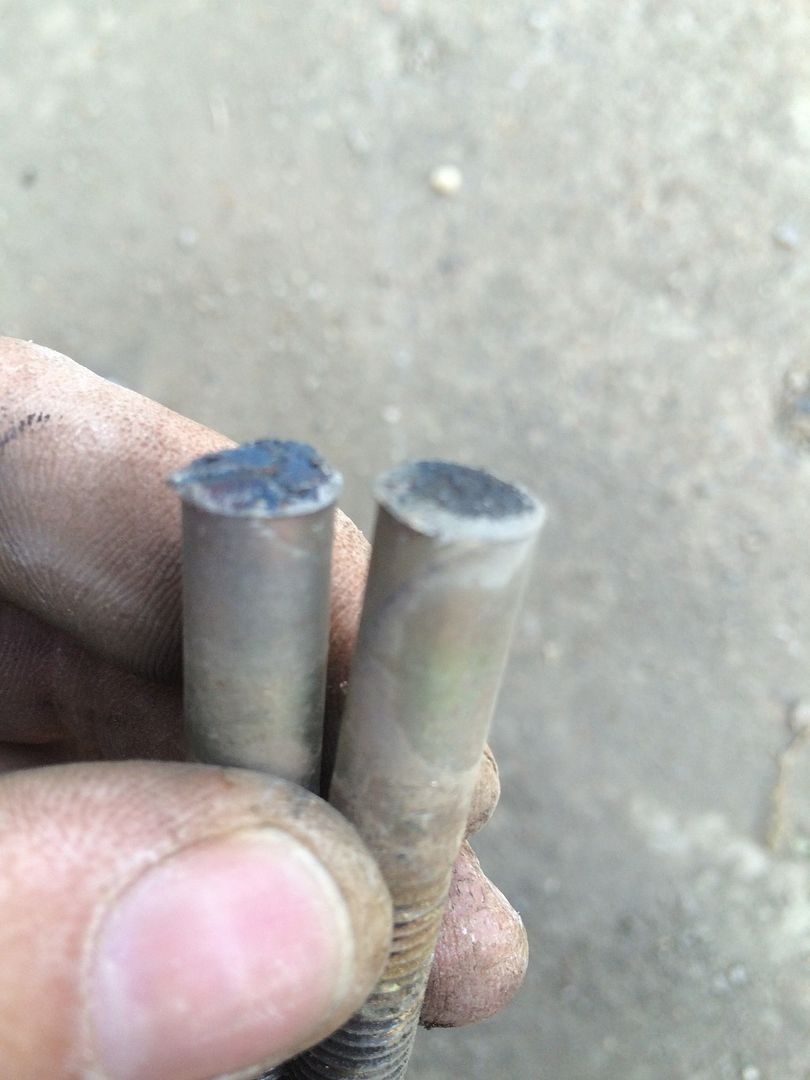
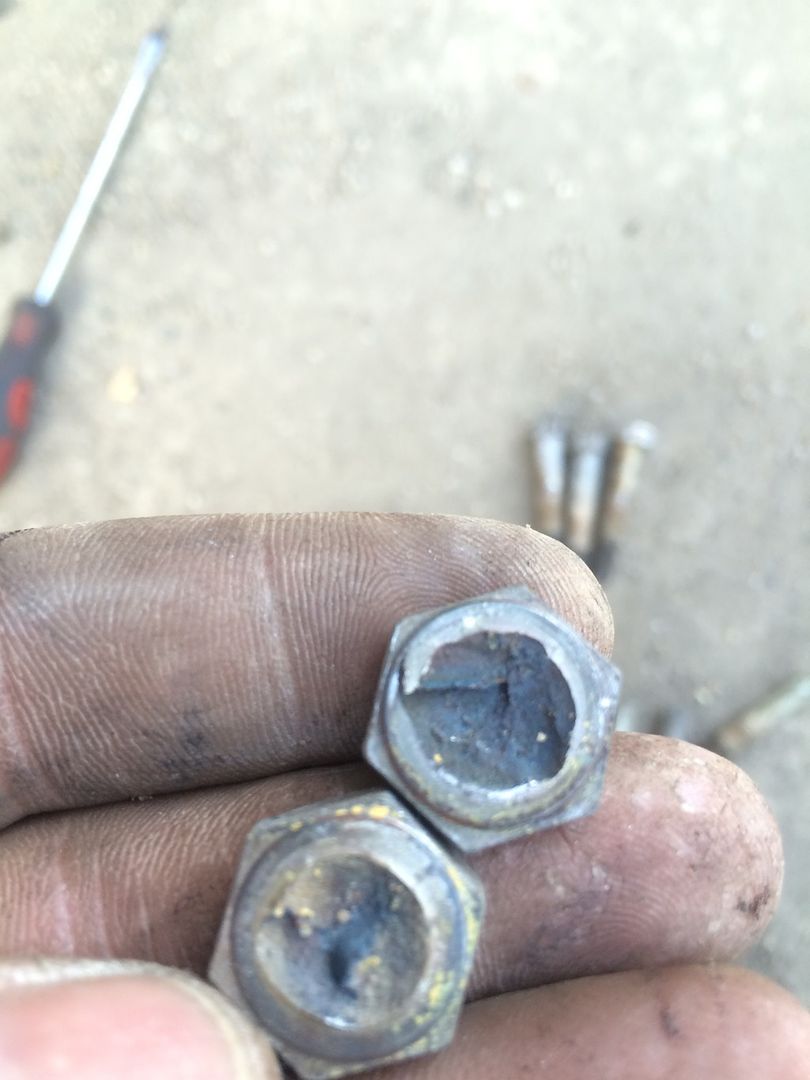
Here is a old bolt compared to the new ones I got.
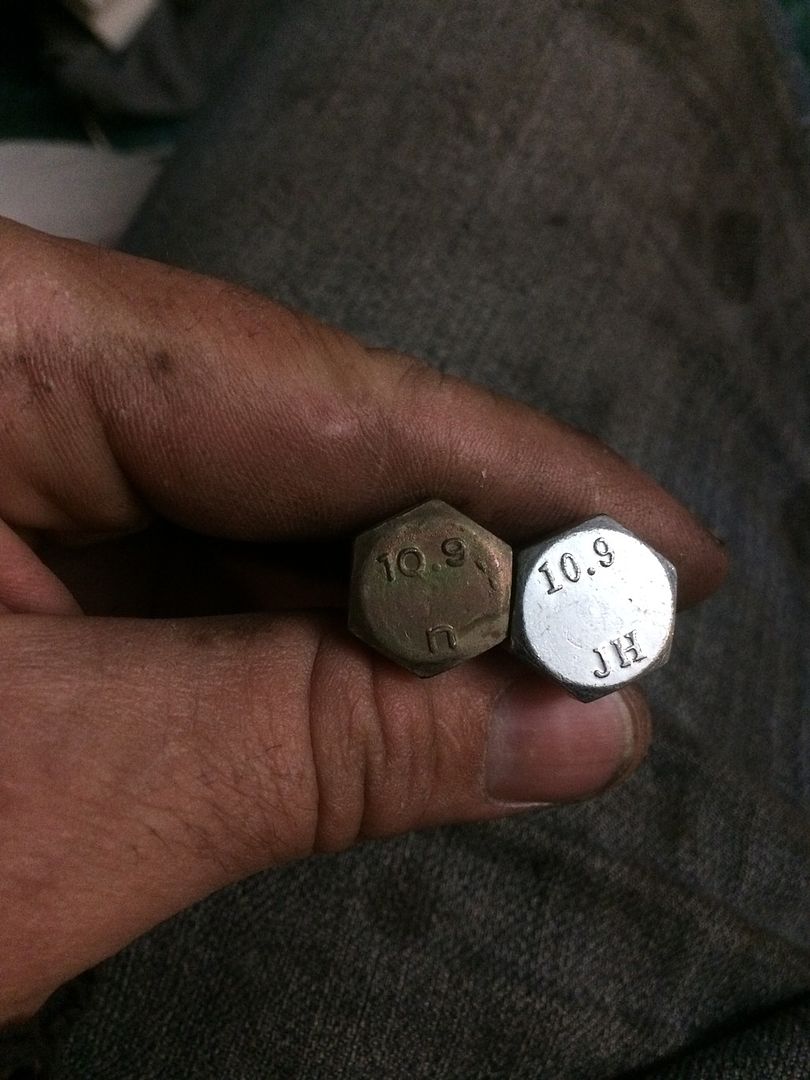
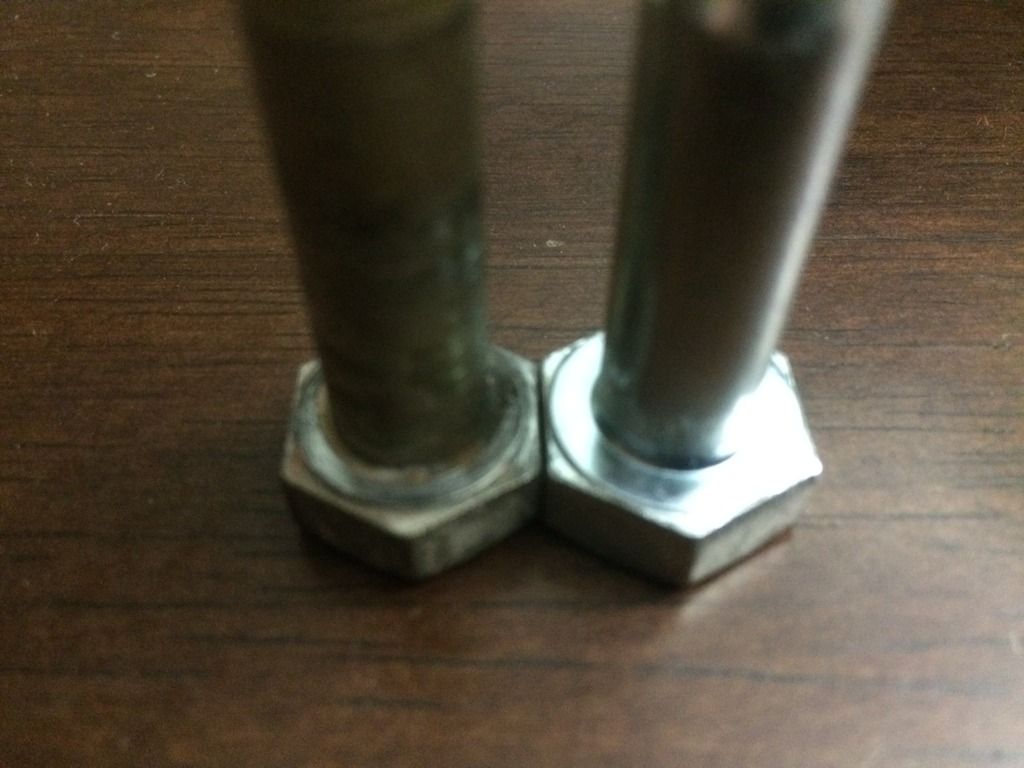
And the finished product.
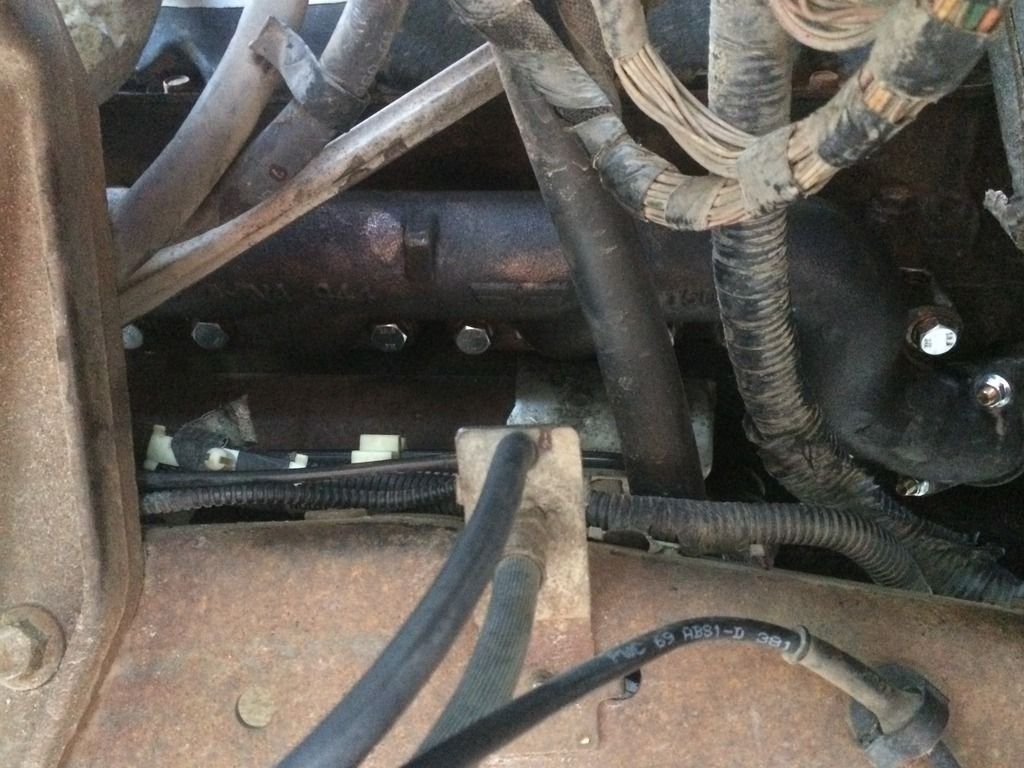
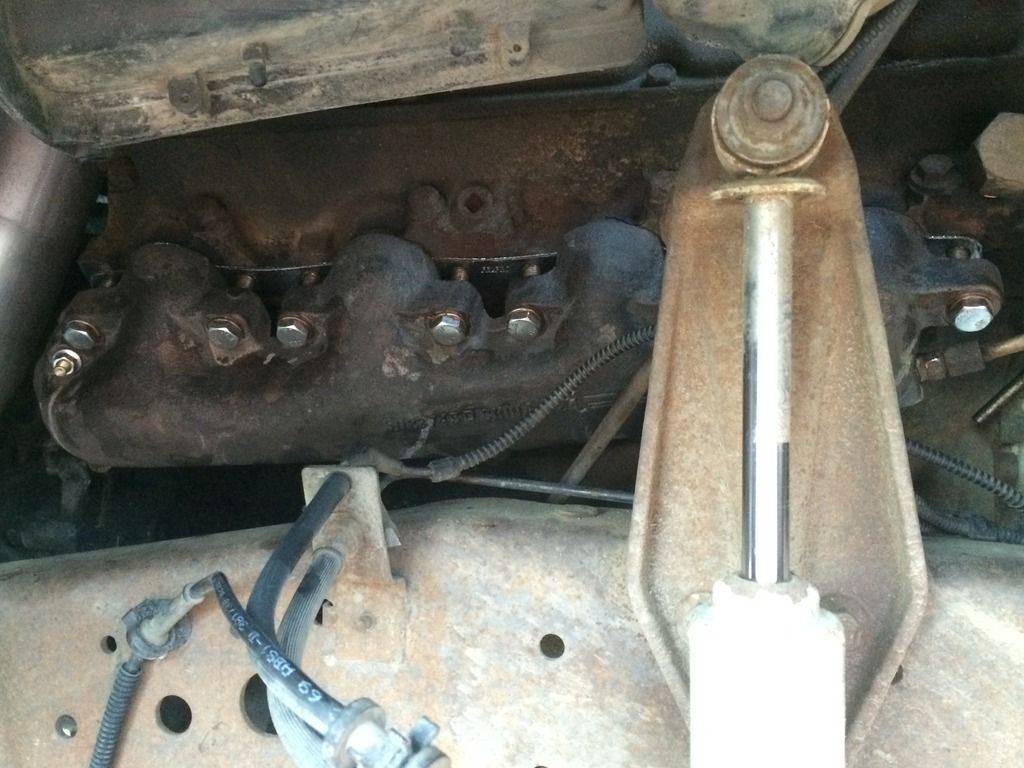
As for gaskets, I use them whenever they are available. I just can't see a metal to metal sealing as well as a gasket can. Some say ya, some say no... Time will tell.
Here's why I thing the wrench wasn't in spec.


Here is a old bolt compared to the new ones I got.


And the finished product.


As for gaskets, I use them whenever they are available. I just can't see a metal to metal sealing as well as a gasket can. Some say ya, some say no... Time will tell.
#41
Great pics Dave! Are the OE bolts 10.9's? If not, why did you choose them?
I think the threaded portion of the bolt going through the manifold is the cause of many of the headaches I've had removing these bolts. I always coat this area liberally with copper antisieze.
As for gaskets, there are over a million 7.3's still on the road with no gaskets and leaks here are uncommon - even with broken bolts. I have removed a few sets of leaky gaskets on trucks whose PO's must have also thought they were a good idea... Even a stock truck is apt to see 1200*F here - but anything 'tuned' can easily see EGT's well above that. You may have better luck, but I see a gasket here as a potential failure point that doesn't exist without it.
I think the threaded portion of the bolt going through the manifold is the cause of many of the headaches I've had removing these bolts. I always coat this area liberally with copper antisieze.
As for gaskets, there are over a million 7.3's still on the road with no gaskets and leaks here are uncommon - even with broken bolts. I have removed a few sets of leaky gaskets on trucks whose PO's must have also thought they were a good idea... Even a stock truck is apt to see 1200*F here - but anything 'tuned' can easily see EGT's well above that. You may have better luck, but I see a gasket here as a potential failure point that doesn't exist without it.
#42
I had a neon years ago, that I spent a month+ chasing down a miss and major driveablity problems. It turned out to be an exhaust leak at the factory no-gasket manifold to head joint. Once I put a gasket in, and ran 3 cans of seafoam through the motor (to remove the carbon buildup from the exhaust leak caused poor running), it ran like a top.
I doubt the factory skips the gasket because it is the best way to seal it. I would guess they do it because they can get away with it on brand new parts. It works good enough, long enough that they escape most warranty claims and save a few dollars each, on millions of vehicles. The problem comes once the original joint gets disturbed years later; long after its not the OEM's problem. Now, that said, cheap paper gaskets can certainly cause problems, but if you buy good quality multi layer metal, or composite gaskets, and torque them properly, you'll be fine.
#44
I agree with what I saw only two things I would point out.
1) I think with adding gasket it would be mandatory to have a bellowed up pipe. Your changing the distance.
2) When the manifold was off I would have had it machined flat again. Majority of the time when heated with a snapped bolt it will warp. As one part of the manifold had bolts the other parts did not. Add heat cycles and distortion occurs. You most likely got away with it because the gasket will take up the slack so to speak in your case.
It still amazes me with the pressure that it takes to drive the turbo to full boost. That factory they do not have a leak without a gasket.
PS: With the EX bolts on a FE witch are a broken PITA I weld the nut on. Then heat the head up to dull orange / cherry. Always use a impact as a wrench puts a twist to it. And a ratchet the same unless you hold it just right. A impact will if you do it right tap the nut out. Dont do a NASCAR drive to it. Just a slow drive ramping it up till it breaks or comes out. Sometimes it will take 2-3 times on a very stubborn bolt. Never lost yet. And the best results are in the winter when you can set the socket outside in the snow. It will cool the nut and bolt while the head it still hot. Freezer works but not as well. Just a FYI for you guys. Thats how I do it in my machine shop
1) I think with adding gasket it would be mandatory to have a bellowed up pipe. Your changing the distance.
2) When the manifold was off I would have had it machined flat again. Majority of the time when heated with a snapped bolt it will warp. As one part of the manifold had bolts the other parts did not. Add heat cycles and distortion occurs. You most likely got away with it because the gasket will take up the slack so to speak in your case.
It still amazes me with the pressure that it takes to drive the turbo to full boost. That factory they do not have a leak without a gasket.
PS: With the EX bolts on a FE witch are a broken PITA I weld the nut on. Then heat the head up to dull orange / cherry. Always use a impact as a wrench puts a twist to it. And a ratchet the same unless you hold it just right. A impact will if you do it right tap the nut out. Dont do a NASCAR drive to it. Just a slow drive ramping it up till it breaks or comes out. Sometimes it will take 2-3 times on a very stubborn bolt. Never lost yet. And the best results are in the winter when you can set the socket outside in the snow. It will cool the nut and bolt while the head it still hot. Freezer works but not as well. Just a FYI for you guys. Thats how I do it in my machine shop

#45
Great pics Dave! Are the OE bolts 10.9's? If not, why did you choose them?
I think the threaded portion of the bolt going through the manifold is the cause of many of the headaches I've had removing these bolts. I always coat this area liberally with copper antisieze.
As for gaskets, there are over a million 7.3's still on the road with no gaskets and leaks here are uncommon - even with broken bolts. I have removed a few sets of leaky gaskets on trucks whose PO's must have also thought they were a good idea... Even a stock truck is apt to see 1200*F here - but anything 'tuned' can easily see EGT's well above that. You may have better luck, but I see a gasket here as a potential failure point that doesn't exist without it.
I think the threaded portion of the bolt going through the manifold is the cause of many of the headaches I've had removing these bolts. I always coat this area liberally with copper antisieze.
As for gaskets, there are over a million 7.3's still on the road with no gaskets and leaks here are uncommon - even with broken bolts. I have removed a few sets of leaky gaskets on trucks whose PO's must have also thought they were a good idea... Even a stock truck is apt to see 1200*F here - but anything 'tuned' can easily see EGT's well above that. You may have better luck, but I see a gasket here as a potential failure point that doesn't exist without it.
I agree. I would never put any kind of metal to metal exhaust joint back together without a gasket. When I rebuilt my turbo, there was no way I was installing my new EBPV delete exhaust adapter without a gasket. It just didn't sit right with me. So, I used high temp copper RTV. It works great; no leaks.
I had a neon years ago, that I spent a month+ chasing down a miss and major driveablity problems. It turned out to be an exhaust leak at the factory no-gasket manifold to head joint. Once I put a gasket in, and ran 3 cans of seafoam through the motor (to remove the carbon buildup from the exhaust leak caused poor running), it ran like a top.
I doubt the factory skips the gasket because it is the best way to seal it. I would guess they do it because they can get away with it on brand new parts. It works good enough, long enough that they escape most warranty claims and save a few dollars each, on millions of vehicles. The problem comes once the original joint gets disturbed years later; long after its not the OEM's problem. Now, that said, cheap paper gaskets can certainly cause problems, but if you buy good quality multi layer metal, or composite gaskets, and torque them properly, you'll be fine.
I had a neon years ago, that I spent a month+ chasing down a miss and major driveablity problems. It turned out to be an exhaust leak at the factory no-gasket manifold to head joint. Once I put a gasket in, and ran 3 cans of seafoam through the motor (to remove the carbon buildup from the exhaust leak caused poor running), it ran like a top.
I doubt the factory skips the gasket because it is the best way to seal it. I would guess they do it because they can get away with it on brand new parts. It works good enough, long enough that they escape most warranty claims and save a few dollars each, on millions of vehicles. The problem comes once the original joint gets disturbed years later; long after its not the OEM's problem. Now, that said, cheap paper gaskets can certainly cause problems, but if you buy good quality multi layer metal, or composite gaskets, and torque them properly, you'll be fine.
Actually bolts I used this time are made in Taiwan, and they have been tested to meet specs and are gov approved/registered hardware Fastener Quality Act (FQA) | USPTO
The first bolts I used, I couldn't find on that site, so they where prob junk in the first place.
I agree with what I saw only two things I would point out.
1) I think with adding gasket it would be mandatory to have a bellowed up pipe. Your changing the distance.
2) When the manifold was off I would have had it machined flat again. Majority of the time when heated with a snapped bolt it will warp. As one part of the manifold had bolts the other parts did not. Add heat cycles and distortion occurs. You most likely got away with it because the gasket will take up the slack so to speak in your case.
It still amazes me with the pressure that it takes to drive the turbo to full boost. That factory they do not have a leak without a gasket.
PS: With the EX bolts on a FE witch are a broken PITA I weld the nut on. Then heat the head up to dull orange / cherry. Always use a impact as a wrench puts a twist to it. And a ratchet the same unless you hold it just right. A impact will if you do it right tap the nut out. Dont do a NASCAR drive to it. Just a slow drive ramping it up till it breaks or comes out. Sometimes it will take 2-3 times on a very stubborn bolt. Never lost yet. And the best results are in the winter when you can set the socket outside in the snow. It will cool the nut and bolt while the head it still hot. Freezer works but not as well. Just a FYI for you guys. Thats how I do it in my machine shop
1) I think with adding gasket it would be mandatory to have a bellowed up pipe. Your changing the distance.
2) When the manifold was off I would have had it machined flat again. Majority of the time when heated with a snapped bolt it will warp. As one part of the manifold had bolts the other parts did not. Add heat cycles and distortion occurs. You most likely got away with it because the gasket will take up the slack so to speak in your case.
It still amazes me with the pressure that it takes to drive the turbo to full boost. That factory they do not have a leak without a gasket.
PS: With the EX bolts on a FE witch are a broken PITA I weld the nut on. Then heat the head up to dull orange / cherry. Always use a impact as a wrench puts a twist to it. And a ratchet the same unless you hold it just right. A impact will if you do it right tap the nut out. Dont do a NASCAR drive to it. Just a slow drive ramping it up till it breaks or comes out. Sometimes it will take 2-3 times on a very stubborn bolt. Never lost yet. And the best results are in the winter when you can set the socket outside in the snow. It will cool the nut and bolt while the head it still hot. Freezer works but not as well. Just a FYI for you guys. Thats how I do it in my machine shop


I checked the manifolds with a machinist strait edge, and are in spec.
I too always have at broken bolts with a welder before any other method. I've got them out of aluminum, cast, steel, and what ever else is found on a auto with just nuts, a welder, and wrenches. I've had good luck with the tighten to loosen method. After welding a nut on, Snug it a bit first than loosen.




